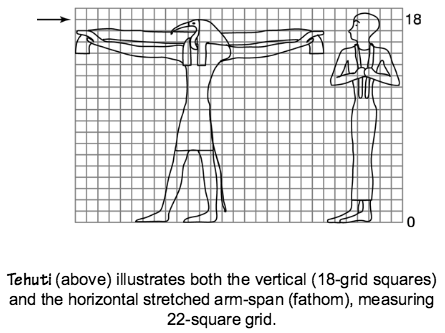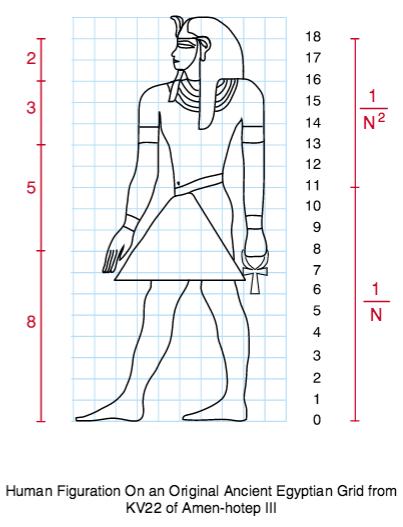The Cosmic Proportion Of The Human Figure
Proportion is the commensuration of the various constituent parts with the whole. The human body is a prime example of such harmonic proportion, where the human frame has been formed with such propriety that the several members are commensurate with the whole.
The Ancient Egyptian canon for the harmonic proportion of human figures differed only between children and adults. The differences were reflective of the actual physical differences at these two stages. At birth, it is the navel that divides the height of child into two halves. Upon maturation (reaching puberty), the junction of both legs (reproductive organs) is at mid-height of the adult figure. The position of the navel now divides the height into unequal parts that make the parts and the whole in compliance with the Neb (Golden) Proportion.
The oldest discovered records from the 5th Dynasty show that the highest defined point along the vertical axis is the hairline of the person’s head, when presented in the earthly realm.
Egyptian figurations carefully mark—with a headband, crown, diadem, or joint—a dividing line for the top of the skull of the earthly man, thus separating the crown of the skull. The height of the body was measured exclusive of the crown, as shown herein in this recovered Ancient Egyptian grid.
The representation of the neteru (gods/goddesses) and/or human beings in the afterlife are shown on an 18-square grid, for the full height to the top of the head (i.e. including the crown of the head).
The difference in the height between the two realms reflects the Ancient Egyptian’s deep understanding of the physiology and role of humans on Earth.
The removal of this part of the human brain (the crown of the head) leaves man alive but without discernment, hence with no personal judgment. The person is in a vegetative state, living and acting only as the executant of an impulse that he receives, without actual choice. It is like a person in a coma.
The navel is located about 11.1 grid squares from the bottom of the heel on the 18-square grid system (or the same equivalent ratio 0.618 for grid or non-grid systems). Such division follows the laws of harmony between the two parts themselves, and the parts to the whole, as per the following two relationships:
1. The ratio between the Two (top and lower) Parts of the divine height (18 grid squares) are harmonic.
Top : Lower is 0.618
Lower : Top is 1.618
2. Between the Two Parts to the whole Unity (divine height)—taking the full height (to the hairline of the earthly man’s head) as 1—the body from the feet to the navel, in the Egyptian canon, is equal to the reciprocal of the Neb (Golden) Proportion (1/N), i.e. 0.618. The portion from the navel to the hairline of the head equals the power 2 of the reciprocal of the Neb (Golden) Proportion (1/N2), or 0.382.
1 / N + 1 / N2 = 1
0.618 + 0.382 = 1
where N = the Neb (Golden) Proportion (1.618)
Because of the intimate relationship between the Summation Series and the Neb (Golden) proportion, we find that the different parts of the figure also follow the Summation Series [as depicted in the above original grid from KV22 of Amenhotep III].
More about mathematics in Ancient Egypt in the appendices section of this book.
[An excerpt from The Ancient Egyptian Metaphysical Architecture by Moustafa Gadalla]
https://egyptianwisdomcenter.org/product/the-ancient-egyptian-metaphysical-architecture/
https://egyptianwisdomcenter.org/product/the-ancient-egyptian-metaphysical-architecture/


